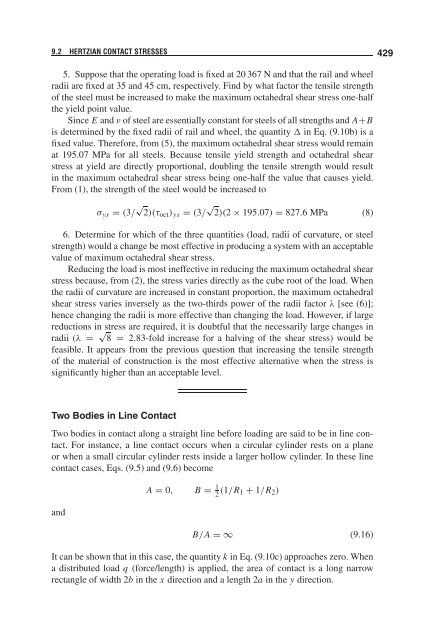9 Contact Stresses
9 Contact Stresses
9 Contact Stresses
Create successful ePaper yourself
Turn your PDF publications into a flip-book with our unique Google optimized e-Paper software.
9.2 HERTZIAN CONTACT STRESSES 429<br />
5. Suppose that the operating load is fixed at 20 367 N and that the rail and wheel<br />
radii are fixed at 35 and 45 cm, respectively. Find by what factor the tensile strength<br />
of the steel must be increased to make the maximum octahedral shear stress one-half<br />
the yield point value.<br />
Since E and ν of steel are essentially constant for steels of all strengths and A+B<br />
is determined by the fixed radii of rail and wheel, the quantity in Eq. (9.10b) is a<br />
fixed value. Therefore, from (5), the maximum octahedral shear stress would remain<br />
at 195.07 MPa for all steels. Because tensile yield strength and octahedral shear<br />
stress at yield are directly proportional, doubling the tensile strength would result<br />
in the maximum octahedral shear stress being one-half the value that causes yield.<br />
From (1), the strength of the steel would be increased to<br />
σys = (3/ √ 2)(τoct)ys = (3/ √ 2)(2 × 195.07) = 827.6 MPa (8)<br />
6. Determine for which of the three quantities (load, radii of curvature, or steel<br />
strength) would a change be most effective in producing a system with an acceptable<br />
value of maximum octahedral shear stress.<br />
Reducing the load is most ineffective in reducing the maximum octahedral shear<br />
stress because, from (2), the stress varies directly as the cube root of the load. When<br />
the radii of curvature are increased in constant proportion, the maximum octahedral<br />
shear stress varies inversely as the two-thirds power of the radii factor λ [see (6)];<br />
hence changing the radii is more effective than changing the load. However, if large<br />
reductions in stress are required, it is doubtful that the necessarily large changes in<br />
radii (λ = √ 8 = 2.83-fold increase for a halving of the shear stress) would be<br />
feasible. It appears from the previous question that increasing the tensile strength<br />
of the material of construction is the most effective alternative when the stress is<br />
significantly higher than an acceptable level.<br />
Two Bodies in Line <strong>Contact</strong><br />
Two bodies in contact along a straight line before loading are said to be in line contact.<br />
For instance, a line contact occurs when a circular cylinder rests on a plane<br />
or when a small circular cylinder rests inside a larger hollow cylinder. In these line<br />
contact cases, Eqs. (9.5) and (9.6) become<br />
and<br />
A = 0, B = 1 2 (1/R1 + 1/R2)<br />
B/A =∞ (9.16)<br />
It can be shown that in this case, the quantity k in Eq. (9.10c) approaches zero. When<br />
a distributed load q (force/length) is applied, the area of contact is a long narrow<br />
rectangle of width 2b in the x direction and a length 2a in the y direction.
















